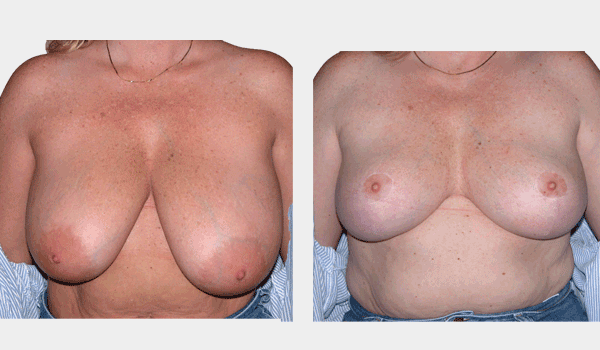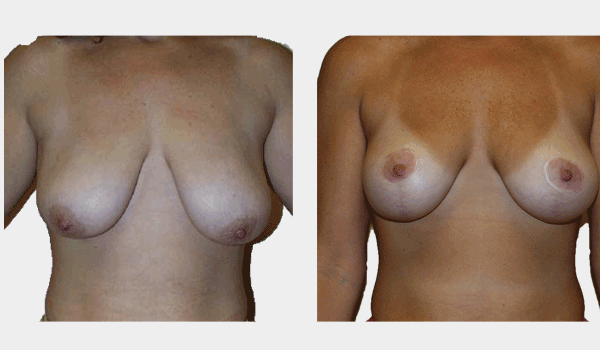Ptosis (Toe-Sis) – Sagging of the Breast
Ptosis by definition means sagging. Ptosis is usually present in patients who have overly large breasts (macromastia). How we approach the issue depends upon the extent and the degree of ptosis, the size of the breasts, the size and look of the breast that the patient desires, and the anatomical architecture associated with the breast. In certain cases, we recommend a Breast Reduction.
Most patients who seek medical attention and breast reduction because of overly large breasts have what Plastic Surgeons call second-degree or third-degree ptosis. This is where the nipple sits substantially below the inframammary fold, or it sits below the fold and points downwards.
A sagging breast is longer than a non-sagging breast, and this length can affect your anatomy. The length of the breast, or what engineers call the “moment-arm”, affects the amount of pull on your chest wall. This, combined with the heavy weight of a large breast, can pull and affect the musculature of the chest and shoulder girdle. Both the weight of the breast, and the shape of the breast, play a role.
Most commonly, patients with macromastia will complain of chronic neck pain, tension headaches, back pain, discomfort wearing a bra, having to constantly readjust their bra, strap marks from their bra, and irritation in the skin under their breasts. Some patients may even complain of tingling or numbness in their fingers. Typically, the excessive weight of the breast and the length of the breast can affect the dynamic relationship of the skeleton, muscles and nerves in the entire shoulder girdle and neck region.
In very large breasted women, the muscle on the chest wall, the pectoralis major muscle, can actually be pulled away from the ribs. This may affect how it functions, and in Dr. Schneider’s experience, this is related to upper back and neck pain.
Typically, Dr. Schneider finds that the back and neck pain that is caused by long and large breasts is improved or gone within 1-2 days after the breast reduction and breast lift surgery. This is because the moment-arm length is reduced, and the tension on the pectoralis muscle is relieved. In fact, we are usually very pleased that the day after surgery, even though the patient will have some breast pain, their back and neck pain is usually relieved.
Breast Reduction Incisions
There are two types of incision that are typically used for a breast reduction:
- Lollipop Incision
- Anchor Incision
Though the lollipop incision is technically more difficult to perform, especially in larger breasts, Dr. Schneider has perfected his technique and has used it almost exclusively since 1995. Since that time, he has used it in many 100’s of patients.
The advantage of the lollipop incision is that it produces significantly less scarring on the breast, eliminating the long scar under the fold of the breast. It also uses a blood supply to the nipple that comes from the top of the breast rather than the bottom of the breast. Many surgeons believe this is superior.
The Procedure
The breast reduction procedure performed by Dr. Schneider takes 2 – 2.5 hours to perform. It is done as an outpatient procedure, meaning that the patient is able to go home from the operation on the same day of the breast reduction surgery, and is performed in our AAAHC certified in-office surgery center.
Breast reduction is performed with the patient having a deep twilight anesthesia. Once the patient is asleep, an anesthetic fluid that is typically used during liposuction is injected into the breast. This fluid decreases bleeding and acts as an anesthetic for 12- 24 hours following the procedure so that the patient is comfortable.
Liposuction is then performed on certain areas of the breast and along the side of the breast where many women have fullness that they do not like. Once this accomplished, the incisions on the breast are created, breast tissue is removed, and the remaining breast tissue is reshaped and sutured to create the higher, smaller breast. Sometimes, at the end of the procedure, a small tube called a drain is placed and brought out the bottom of the breast incision. If a drain is placed, it is removed in the office the next day.
All stitching in the breast is performed with internal, absorbable sutures that do not need to be removed. There are no stitches put in the skin that need to be removed.
Breast Reduction Recovery
Most patients are able to return to work in 5-7 days after the procedure. The day or two after the procedure, the patients are asked to return to the office to check the dressings, and if necessary, remove the drains. Sometimes there can be a small amount of bleeding along the edges of the incisions. If there is no bleeding, the patients may shower 24 hours after the surgery. If there are some spots of bleeding, they are asked to wait 24 hours after this has stopped before they get their breasts wet in the shower. This may take 2-3 days.
We ask patients not to lift anything more than about what a large purse holds (about 10 pounds), or reach with their arms for 6 weeks. We ask this because the breast tissue that has been sewn together internally during the operation takes about 6 weeks to become strong.
During that time we like patients to wear either a supportive bra or the special tape Dr. Schneider applies. Scar creams or ointments are not necessary to use or purchase. After six weeks, you may resume all normal activities and bra choices.
Financing Your Breast Reduction
Buy Now. Pay Monthly. Let your money go further and take better control of your cash flow when you pay in smaller, more manageable monthly installments with our financing options. Choose from a range of monthly payment plans with some qualifying for 0% APR options.















